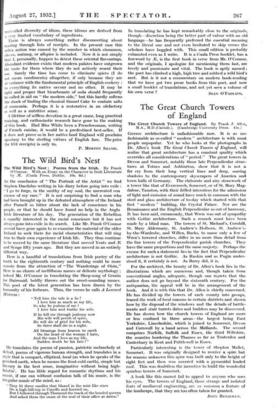The Great Church Towers of England
The Great Church Towers of England. By Frank J. Allen, M.A., M.D.(Cantab.). (Cambridge University Press. 45s.) GOTHIC architecture is unfashionable now. It is as un- fashionable as so-called " modem " architecture is with most people unpopular. Yet he who looks at the photographs in Dr. Allen's book The Great Church Towers of England, will realize that great architecture has a constant quality which overrides all considerations of " period." The great towers in Devon and Somerset, notably those late Perpendicular struc- tures at Totnes and Ashburton, show that it is not a far cry from their long vertical lines and deep, soaring shadows to the contemporary skyscrapers of America and town halls of Germany. The elaborate and airy stonework of a tower like that of Evercreech, Somerset, or of St. Mary Mag- dalene, Taunton, with their frilled interstices for the admission of light and emission of sound have much in common with the steel and glass architecture of to-day which started with that first " modern " building, the Crystal Palace. Nor are the Renaissance and the English Perpendicular so out of harmony. It has been said, erroneously, that Wren was out of sympathy with Gothic architecture. Such a remark must have been made by a blind man. The towers of St. Michael's, Cornhill, St. Mary Aldermary, St. Andrew's Holborn, St. Andrew's- by-the-Wardrobe, and Witten, Bucks, to name only a few of Wren's towered churches, differ in no more than detail from the fine towers of the Perpendicular parish churches. They have the same proportions and the same majesty. Perhaps the excuse for such a statement lies in the fact that Perpendicular architecture is not Gothic. As Ruskin and as Pugin under- stood it, it certainly is not. As Barry did, it is.
For the architect, the beauty of Dr. Allen's book lies in the illustrations which are numerous and, though taken from conventional angles, adequate, though one regrets that the author does not go beyond the sixteenth century. For the antiquarian, the appeal will be in the arrangement of the book. And it is with this that Dr. Allen is chiefly concerned. He has divided up the towers of each county into groups, traced the work of local masons in certain districts and shown how by the disposal of the windows and the details of battle- ments and stair turrets dates and builders may be discovered. He has shown how the church towers of England are more or less confined to three areas—the largest being East Yorkshire, Lincolnshire, which is joined to Somerset, Devon and Cornwall by a band across the Midlands. The second comprises Norfolk, Suffolk and EssPx, the third Wiltshire, the counties bordering the Thames as far as Tenterden and Canterbury in Kent and Prittlewell in Essex.
Particularly interesting is the tower of Shepton Mallet, Somerset. It was originally designed to receive a spire but for reasons unknown this spire was built only to the height of eight feet and then was covered with a pyramidal leaded roof. , This was doubtless the incentive to build the wonderful spireless towers of Somerset.
A book like this cannot fail to appeal to anyone who uses his eyes. The towers of England, those strange and isolated feats of mediaeval engineering, arc so common a feature of the landscape, that they are too often taken for granted.
JOHN BETJEM A N.


























 Previous page
Previous page